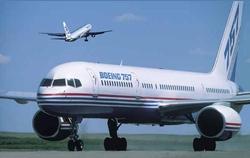Area Of Cracking And Rupture Not Seen During Previous
Inspections
In the probable cause report released last week concerning the
rapid decompression of an American Airlines B757 departing from
Miami on October 26, 2010, the NTSB says 'incorrect manufacturing'
was the source of an 18x7 inch hole which opened up in the upper
fuselage of the airplane. Fortunately, the 757 landed safely back
at Miami, and no one was injured in the incident.
File Photo

NTSB Identification: DCA11FA004
Scheduled 14 CFR Part 121: Air Carrier operation of AMERICAN
AIRLINES INC
Accident occurred Tuesday, October 26, 2010 in Miami, FL
Probable Cause Approval Date: 09/19/2011
Aircraft: BOEING 757-223, registration: N626AA
Injuries: 160 Uninjured.
Flight data recorder data revealed that, after takeoff from
Miami International Airport (MIA), Miami, Florida, the airplane
climbed for about 16 minutes and was passing through an altitude of
approximately 32,000 feet when the rapid decompression occurred.
The flight crew declared an emergency (the first officer was the
pilot flying) and returned to MIA. Post accident examination of the
airplane revealed fatigue cracking of the upper fuselage skin above
the forward left passenger (L1) door. The fatigue cracking
penetrated the fuselage skin, leading to a rupture and an
approximate 18-inch-by-7-inch hole that depressurized the
airplane.
NTSB examinations of a section of the fuselage crown skin (from
body station 374 to body station 439) where the rupture occurred
revealed fatigue cracking along the lower longitudinal step of the
chemically milled pocket just above the stringer S-4L (left) lap
joint. The fatigue cracking initiated on the interior surface of
the skin at multiple locations and propagated through the skin
thickness. The skin thickness at the base of the chemically milled
step measured 0.035 to 0.037 inch—which is less than the
0.039-inch minimum thickness specified by Boeing. Calculations from
an NTSB study of the fatigue striation density and propagation in
the fatigue region indicate that it would take an average of 3,709
total cycles for a crack to grow through skin with 0.035-inch
thickness and an average interval of 917 cycles for a crack to grow
from a minimally detectable size and penetrate a 0.035-inch skin
thickness.

The area of cracking and rupture on the accident airplane was
not subject to any specific inspections, service bulletins (SB), or
airworthiness directives (AD) at the time of the accident.
Following the accident, on November 22, 2010, Boeing issued SB
757-53-0097, which called for repetitive external inspections
(every 30, 200 cycles, or 300 hours depending on the inspection
method) to detect cracks in the fuselage skin along the chemically
milled step at stringers S-4L (left) and S 4R (right) between body
station 297 and body station 439. On January 10, 2011, the Federal
Aviation Administration issued AD 2011-01-15 (effective January 25,
2011) mandating the inspections recommended in SB 757-53-0097.
During its investigation, the NTSB learned of a United Airlines
757 and a second American Airlines 757 that exhibited cracking in
the fuselage skin similar to the accident airplane; both had
nonconforming thickness at the base of the chemically milled step
at the stringer location specified in the SB. Records of
manufacture for the skin panels on the accident airplane and the
other airplanes with fuselage skin cracking were not retained, and
were not required to be retained; therefore, a cause for the
manufacturing nonconformance could not be identified.
The National Transportation Safety Board determines the probable
cause(s) of this accident as follows:
Fatigue failure of the fuselage crown skin due to incorrect
manufacturing of the crown skin panel that resulted in a skin
thickness less than the manufacturer-specified thickness.
 ANN's Daily Aero-Linx (04.15.24)
ANN's Daily Aero-Linx (04.15.24) Classic Aero-TV: 'No Other Options' -- The Israeli Air Force's Danny Shapira
Classic Aero-TV: 'No Other Options' -- The Israeli Air Force's Danny Shapira Aero-News: Quote of the Day (04.15.24)
Aero-News: Quote of the Day (04.15.24) Airborne 04.16.24: RV Update, Affordable Flying Expo, Diamond Lil
Airborne 04.16.24: RV Update, Affordable Flying Expo, Diamond Lil ANN's Daily Aero-Term (04.16.24): Chart Supplement US
ANN's Daily Aero-Term (04.16.24): Chart Supplement US




